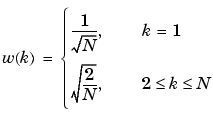

| Signal Processing Toolbox |   |
Discrete cosine transform (DCT)
Syntax
Description
y = dct(x)
returns the unitary discrete cosine transform of x


N is the length of x, and x and y are the same size. If x is a matrix, dct transforms its columns. The series is indexed from n = 1 and k = 1 instead of the usual n = 0 and k = 0 because MATLAB vectors run from 1 to N instead of from 0 to N- 1.
y = dct(x,n)
pads or truncates x to length n before transforming.
The DCT is closely related to the discrete Fourier transform. You can often reconstruct a sequence very accurately from only a few DCT coefficients, a useful property for applications requiring data reduction.
Examples
Find how many DCT coefficients represent 99% of the energy in a sequence:
x=(1:100) + 50*cos((1:100)*2*pi/40); X=dct(x); [XX,ind]=sort(abs(X)); ind=fliplr(ind); i=1; while (norm([X(ind(1:i)) zeros(1,100-i)])/norm(X)<.99) i=i + 1; end i=3
See Also
References
[1] Jain, A.K. Fundamentals of Digital Image Processing. Englewood Cliffs, NJ: Prentice-Hall, 1989.
[2] Pennebaker, W.B., and J.L. Mitchell. JPEG Still Image Data Compression Standard. New York, NY: Van Nostrand Reinhold, 1993. Chapter 4.
 | czt | decimate |  |